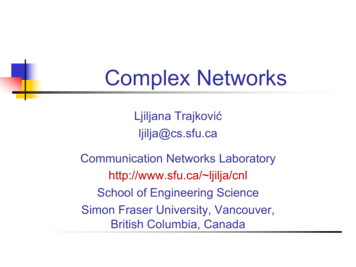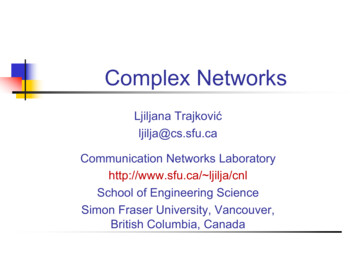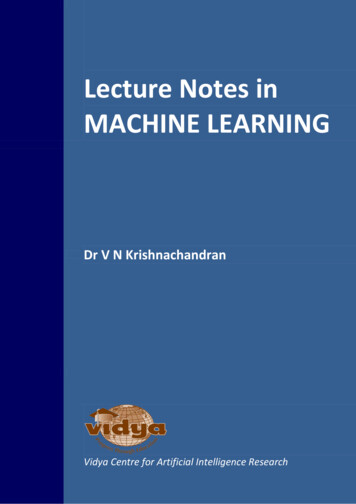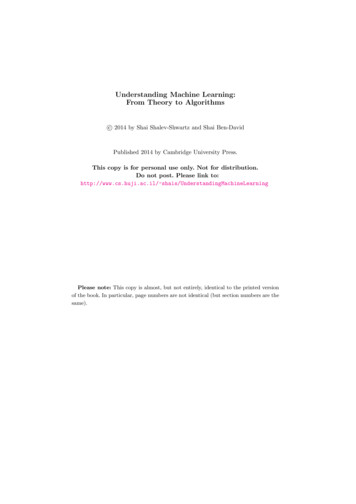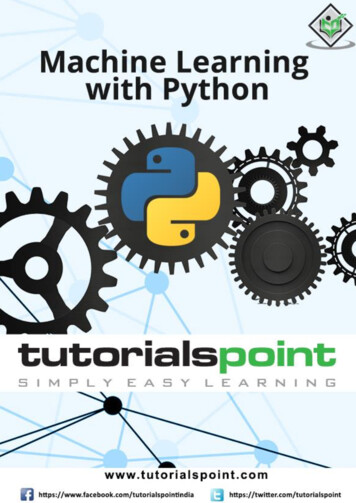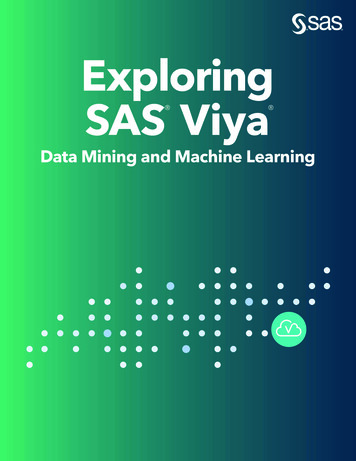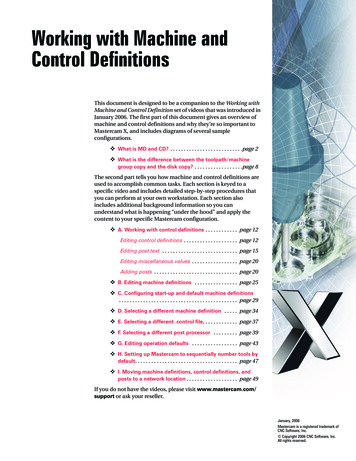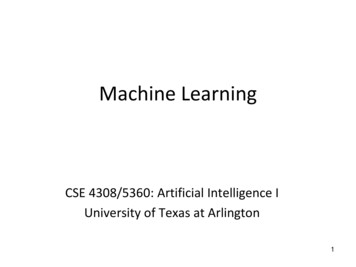
Transcription
Machine LearningCSE 4308/5360: Artificial Intelligence IUniversity of Texas at Arlington1
Machine Learning Machine learning is useful for constructing agents thatimprove themselves using observations. Instead of hardcoding how the agent to behave, we allow thebehavior to be optimized based on training data. In many AI applications in speech recognition, computervision, game-playing, etc., machine learning methods vastlyoutperform hardcoded agents.2
Pattern Recognition In pattern recognition (aka pattern classification) the setting is this: We have patterns, which can be, for example:– Images or videos.– Strings.– Sequences of numbers, booleans, or strings (or a mixture thereof). We have classes, and each pattern is associated with a class.PatternClassA photograph of a faceThe humanA video of a sign from American Sign LanguageThe signA book (represented as a string)The genre of the book. Our goal: build a system that, given a pattern, estimates its class.– E.g., given a photograph of a face, recognize a person.– Given a video of a sign, recognize the sign.3
Pattern Recognition More formally: the goal in pattern recognition is to construct aclassifier that is as accurate as possible. A classifier is a function F, mapping patterns to classes.F: set of patterns set of classes.– The input to F is a pattern (e.g., a photograph of a face).– The output of F is a class (the ID of the human that the face belongs to). Typically, classifiers are not perfect.– In most real-world cases, the classifier will make some mistakes, and forsome patterns it will output the wrong class. One key measure of performance of a classifier is its error rate:the percentage of patterns for which F provides the wronganswer.– Obviously, we want the error rate to be as low as possible. Another term is classification accuracy, equal to 1 – error rate.4
Learning and Recognition Machine learning and pattern recognition are not the same thing.– This is a point that confuses many people. You can use machine learning to learn things that are notclassifiers. For example:– Learn how to walk on two feet.– Learn how to grasp a medical tool. You can construct classifiers without machine learning.– You can hardcode a bunch of rules that the classifier applies to eachpattern in order to estimate its class. However, machine learning and pattern recognition are heavilyrelated.– A big part of machine learning research focuses on pattern recognition.– Modern pattern recognition systems are usually exclusively based onmachine learning.5
Supervised Learning In supervised learning, our training data is a set of pairs. Each pair consists of:– A pattern.– The true class for that pattern. Another way to think about this is this:– There exists a perfect classifier Ftrue, that knows the true class of eachpattern.– The training data gives us the value of Ftrue for many examples.– Our goal is to learn a classifier F, mapping patterns to classes, thatagrees with Ftrue as much as possible. The difficulty of the problem is this:– The training data provide values of Ftrue for only some patterns.– Based on those examples, we need to construct a classifier F thatprovides an answer for ANY possible pattern.6
SupervisedLearningExample This is a toy example.– From the textbook. Here, the “pattern” is a single real number. The class is also a real number. So, Ftrue is a function from the reals to the reals.– Usually patterns are much more complex.– In this toy example it is easy to visualize training examples and classifiers. Each training example is an X on the figure.– The x coordinate is the pattern, the y coordinate is the class. Based on these examples, what do you think Ftrue looks like?7
SupervisedLearningExample Different people may give different answers as to what Ftrue maylook like. That shows the challenge in supervised learning: we can find someplausible functions, but how do we know that one of them iscorrect?8
SupervisedLearningExample Here is one possible classifier F. Can anyone guess how it was obtained?9
SupervisedLearningExample Here is one possible classifier F. Can anyone guess how it was obtained? It was obtained by fitting a line to the training data.10
SupervisedLearningExample Here we see another possible classifier F, shown in green. It looks like a quadratic function (second degree polynomial). It fits all the data perfectly, except for one.11
SupervisedLearningExample Here we see a third possible classifier F, shown in blue. It looks like a cubic degree polynomial. It fits all the data perfectly.12
SupervisedLearningExample Here we see a fourth possible classifier F, shown in orange. It zig-zags a lot. It fits all the data perfectly.13
SupervisedLearningExample Overall, we can come up with an infinite number of possibleclassifiers here. The question is, how do we choose which one is best? Or, an easier version, how do we choose a good one. Or, an easier version: given a classifier, how can we measure howgood it is? What are your thoughts on this?14
SupervisedLearningExample One naïve solution is to evaluate classifiers based on training error. For any classifier F, its training error can be measured as a sum ofsquared errors over training patterns X:𝑋[𝐹𝑡𝑟𝑢𝑒 (𝑋) 𝐹(𝑋) ]2 What are the pitfalls of choosing the “best” classifier based ontraining error?15
SupervisedLearningExample What are the pitfalls of choosing the “best” classifier based ontraining error? The zig-zagging orange classifier comes out as “perfect”: its trainingerror is zero. As a human, would you find more reasonable the orange classifieror the blue classifier (cubic polynomial)?– They both have zero training error.16
SupervisedLearningExample What are the pitfalls of choosing the “best” classifier based ontraining error? The zig-zagging orange classifier comes out as “perfect”: its trainingerror is zero. As a human, would you find more reasonable the orange classifieror the blue classifier (cubic polynomial)?– They both have zero training error.– However, the zig-zagging classifier looks pretty arbitrary.17
SupervisedLearningExample Ockham’s razor: given two equally good explanations, choose themore simple one.– This is an old philosophical principle (Ockham lived in the 14th century). Based on that, we prefer a cubic polynomial over a crazy zigzagging classifier, because it is more simple, and they both havezero training error.18
SupervisedLearningExample However, real life is more complicated. What if none of the classifiers have zero training error? How do we weigh simplicity versus training error?19
SupervisedLearningExample However, real life is more complicated.What if none of the classifiers have zero training error?How do we weigh simplicity versus training error?There is no standard or straightforward solution to this.There exist many machine learning algorithms. Each corresponds toa different approach for resolving the trade-off between simplicityand training error.20
The Road Ahead In the remainder of this course, we will mostly studysupervised learning methods for pattern recognition. Some methods we will see, if we have time:–––––Decision trees.Decision forests.Bayesian classifiers.Nearest neighbor classifiers.Neural networks (in very little detail). Studying these methods should give you a good firstexperience with machine learning and pattern recognition. The current trend in AI is that machine learning and patternrecognition methods are becoming more and more dominant,with rapidly growing commercial applications and impact.21
A video of a sign from American Sign Language Our goal: build a system that, given a pattern, estimates its class. –E.g., given a photograph of a face, recognize a person. –Given a video of a sign, recognize the sign. 3 Pattern Class A photograph of a face The human The sign


